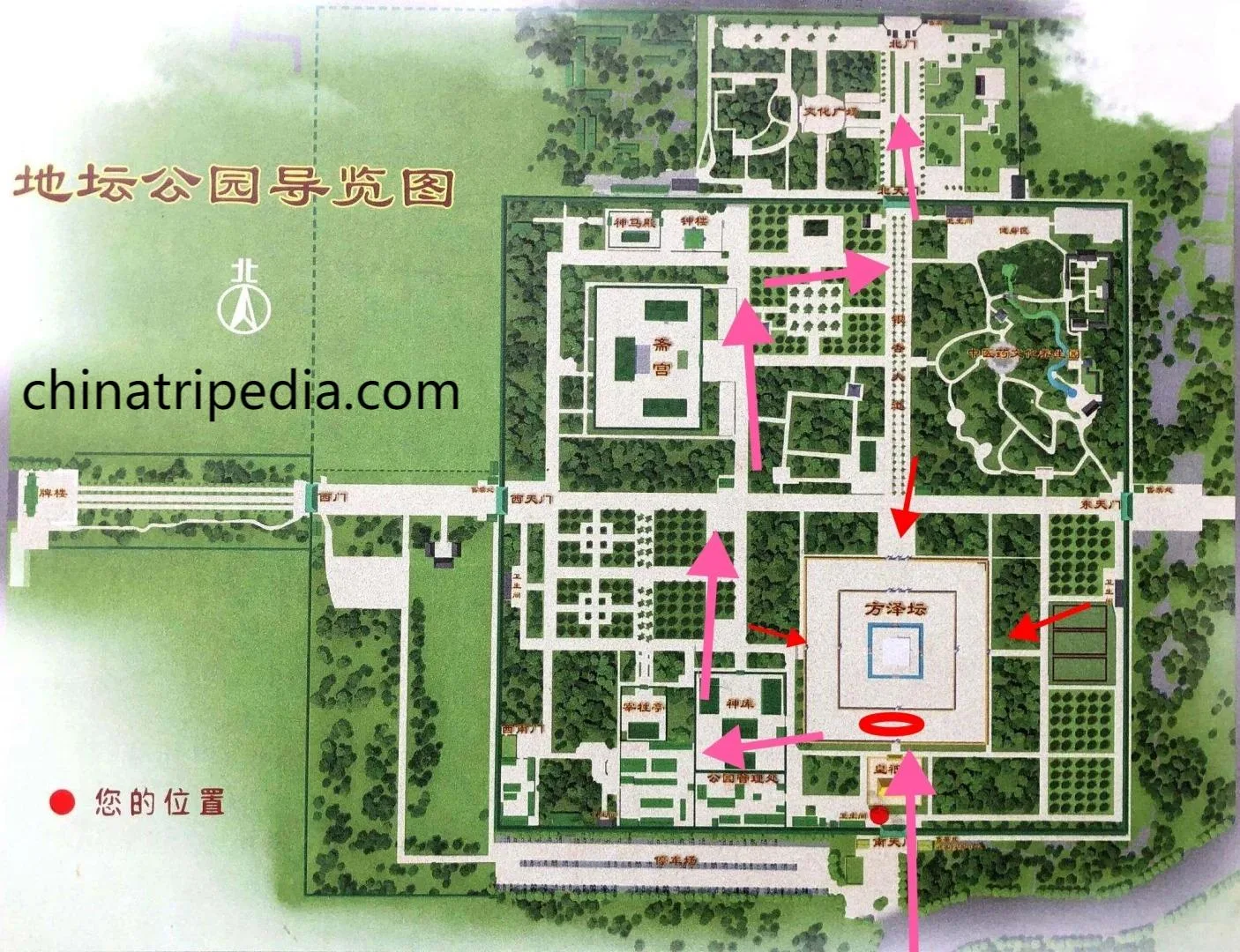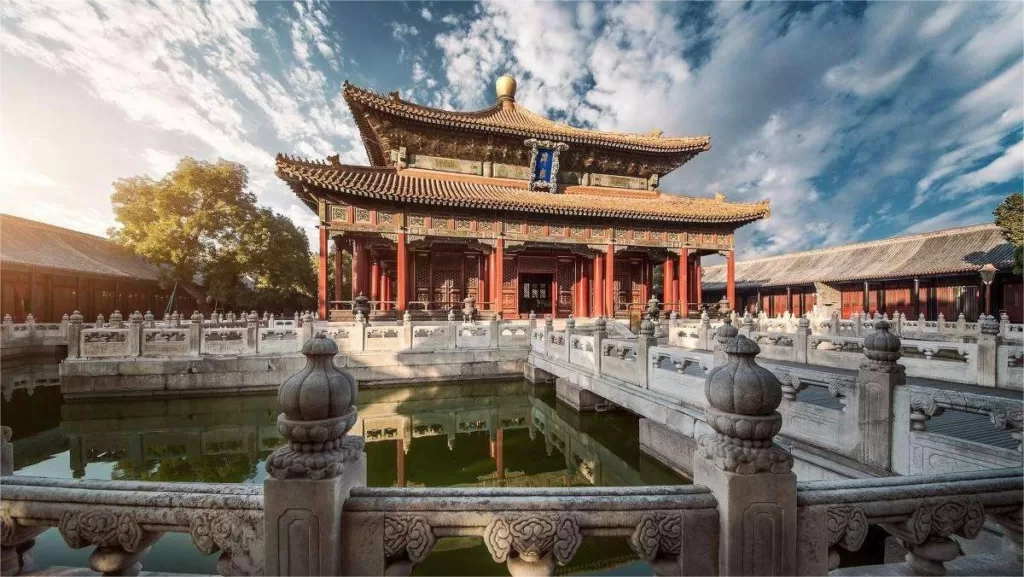The Temple of Earth, also known as Ditan Park (地坛公园), is located in the northern part of Beijing, China. It is one of the oldest and largest temples in the city, covering an area of 37.4 hectares. Built in 1530 during the Ming Dynasty, the temple was initially used for sacrifices to the god of earth and agriculture.
The Temple of Earth is known for its stunning architecture, which reflects traditional Chinese design and culture. Its main entrance is a grand archway adorned with intricate carvings of dragons and other mythical creatures. Inside the temple, visitors can see the impressive Altar of Earth, which is the largest altar in Beijing. The altar is made of white marble and is surrounded by a circular moat.
In addition to the temple itself, Ditan Park is also a popular destination for visitors to enjoy outdoor activities. The park features several beautiful gardens, including a rose garden, a chrysanthemum garden, and a peony garden. There are also numerous walking paths and jogging trails, as well as several lakes where visitors can rent boats and go fishing.
Table of Contents
- Basic Information
- Location and Transportation
- Highlights of the Temple of Earth
- Map and Recommended Route
- Vlog about Temple of Earth
- Best Time to Visit Temple of Earth
- A Brief History of the Temple of Earth
- Phtography Spots and Tips
- Popular Restaurants and Sncks Nearby
- Useful Tips Summarized from Reviews
- Attractions near Temple of Earth
- Explore Beijing Like A Local
Basic Information
| Website | http://www.dtpark.com/ |
| Estimated Length of Tour | About 2 hours |
| Opening Hours | 6.00 – 21.00 (1st May – 31st October) 6.00 – 20.30 (1st November – 30th April) |
| Ticket Price | 2 RMB |
| Telephone Number | 0086-010-64214657 |
Location and Transportation
The Temple of Earth is situated in the northern part of Dongcheng District, close to the Second Ring Road. The exact address is No. 1 Andingmen Outer Street, Dongcheng District, Beijing. Visitors can get there easily by public transport.
Bus
- To the east or south gate: Take bus 117 or 125 and get off at Ditan Dongmen Stop (East gate of the Temple of Earth 地坛东门) or Ditan Nanmen Stop (South gate of the temple 地坛南门).
- To the west gate: Take bus 18, 75, 104, 108, 113, 119, 124, 125, 141, 301, or 430 and get off at Ditan Ximen Stop (地坛西门)
- To the north gate: Take bus 125 and get off at Ditan Beimen Stop (地坛北门)
Subway
- Take subway line 2, get off at Andingmen Station (安定门站), exit the station from Exit B, and walk about 300 meters to the north to reach the west gate of the temple.
- Take subway line 2 or 5, get off at Yonghe Lama Temple Station (雍和宫站), exit the station from Exit A, and walk about 200 meters to the north to reach the south gate of the temple.
Highlights of the Temple of Earth
Fangze Altar

The Fangze Altar (方泽坛), situated within the Temple of Earth, served as the sacred ground for Ming and Qing emperors to worship the “Earth Deity.” Its name, Fangze Altar, derives from the square-shaped pools surrounding the altar platform. Constructed in the ninth year of the Ming Jiajing era (1530 AD), it underwent renovations in the fifteenth year of the Qing Qianlong era (1750 AD) as per Emperor Qianlong’s decree, replacing the yellow glazed brick with greenstone surfaces.
The current architecture reflects the Qing Qianlong-era design restored in 1981. The altar’s square layout symbolizes the ancient belief of “round sky, square earth.” The central platform comprises upper and lower tiers. The lower tier’s southern section features mountain-shaped stone pedestals on the east and west, hosting fifteen mountain-shaped stone deities, honoring the spirits of the Five Mountains, Five Towns, and Five Tombs during ceremonies. The northern section holds water-shaped stone pedestals on the east and west, paying homage to the gods of the Four Seas and Four River Bends during rituals.
Various Gardens

Ditan Park, or the Temple of Earth, features several beautiful gardens that offer visitors a peaceful retreat from the hustle and bustle of the city. The gardens include a rose garden, a chrysanthemum garden, and a peony garden. The rose garden is home to over 500 varieties of roses, with colorful blooms that attract visitors year-round. The chrysanthemum garden features thousands of chrysanthemums of different shapes and sizes, and visitors can admire their vibrant colors and intricate patterns. Finally, the peony garden boasts a wide range of peonies, including many rare and endangered species.
Architectures

Built during the Ming Dynasty, the Temple of Earth features a symmetrical design with a square-shaped main hall and a surrounding courtyard. The structure is made of wood and bricks, and the roofs are adorned with glazed tiles depicting dragons and other mythical creatures. Inside the main hall, there are several altars dedicated to various deities, including the God of Earth and the God of Agriculture.
Map and Recommended Route

Entry Points: The Temple of Earth has four gates for entry and exit: Southeast Gate, South Gate, North Gate, and West Gate. It is recommended to enter from the South Gate as it provides access to the two main attractions currently open to the public. The other attractions have been closed for a long time.
Touring Route: It is suggested to follow the route indicated by the pink arrow (the areas marked in green are no longer open to visitors). The green spaces are visible almost entirely from the Ginkgo Avenue and the scenery near the East Gate can be seen along the way.
Vlog about Temple of Earth
Best Time to Visit Temple of Earth
The best times to visit Temple of Earth Park are during the Spring Book Fair (April-May), Autumn Book Fair (September-October), and Winter Book Fair (November-December). Additionally, the Ginkgo Festival, held in early November, is an exceptional time to visit if you want to experience Beijing’s charming autumn scenery. This festival is a major event at the park, attracting tens of thousands of visitors each year to enjoy the vibrant ginkgo leaves.
A Brief History of the Temple of Earth
The temple was built in the Ming Dynasty (1368-1644) and was initially used for imperial sacrifices to the God of Earth, which was believed to be responsible for a good harvest and the well-being of the people.
The temple was originally located in the northern part of the city, outside the city walls. However, as the city grew, the temple became surrounded by urban development and eventually became part of the city itself. During the Qing Dynasty (1644-1911), it was expanded and renovated several times and became a popular place for people to come and make offerings to the God of Earth.
In 1925, the Temple of Earth was converted into a park and opened to the public. The park was designed to reflect the traditional Chinese concept of a “feng shui” landscape, which emphasized the harmonious interaction between nature and human beings. The park features several hills, a large lake, and many trees and flowers, creating a peaceful and serene environment for visitors.
During the Cultural Revolution in the 1960s and 1970s, many religious and cultural sites in China were damaged or destroyed. The Temple of Earth was no exception, and many buildings and statues were damaged or removed. However, in the 1980s, the government began to restore the temple and park, and today it is once again a popular destination for tourists and locals alike.
Phtography Spots and Tips
Spot 1: The Hall of Prayer for Good Harvests
Tip: Stand on the steps to capture the layered effect of the red walls in the background. This iconic angle creates a classic and impressive photo opportunity. It’s a must-visit spot for capturing the grandeur of the temple.
Spot 2: Magnolia Trees at the Hall of Prayer for Good Harvests
Tip: Even if it’s not the magnolia blooming season, the lush green leaves and the contrasting red walls create a beautiful and serene composition. Look for interesting angles and play with the patterns of light and shadow.
Spot 3: The “Sea” of Temple of Earth
Tip: Enter through the South Gate, turn right, and then left at the end of the path. Use the dappled light and reflections on the wall to create a visual effect reminiscent of a shimmering sea surface.
Spot 4: The Sacred Horse Temple
Tip: The chairs and concrete platforms in front of the Sacred Horse Temple offer excellent photo opportunities. You can also capture unobstructed views of the sky and architectural details.
Spot 5: The Zhai Palace
Tip: From the front entrance of the Zhai Palace, you can photograph the tall cypress trees and the vibrant red walls framed by lush greenery. This spot is perfect for capturing the harmonious blend of nature and architecture.
Popular Restaurants and Sncks Nearby
Wu Yutai Matcha Ice Cream (吴裕泰的抹茶冰淇淋)
- Price: ¥10
- Description: A delightful matcha ice cream with a rich tea flavor that’s smooth and not bitter. Perfect for a refreshing treat after your visit to the Temple of Earth.
Pang Mei Noodle House (胖妹面庄)
- Price: Three-in-One Noodles ¥39, Beef Ribs Noodles ¥42
- Description: Offers typical Chongqing-style noodles. While the taste is authentic, the restaurant is small and often crowded, with a high price for the portion size.
7-11 Ice Cup + Cooer (7-11 冰杯➕酷儿)
- Price: ¥11.5
- Description: A cool and refreshing drink option for summer. This light beverage is great for a quick break while exploring the area.
Sanyuan Meiyuan Red Bean Milk Roll (三元梅园豆沙奶卷)
- Price: ¥18
- Description: Located near the Yonghegong gate, this red bean milk roll is a tasty snack. Though it’s not exceptionally sweet, it’s a pleasant treat with a subtle flavor.
Useful Tips Summarized from Reviews
Entrances: The Temple of Earth has entrances on all four sides: north, south, east, and west. It’s recommended to enter from the South Heavenly Gate (Nantianmen) as the two main open attractions are located nearby. Other areas of the temple may have been closed for a while.
Greenery and Accessibility: The Temple of Earth is known for its lush greenery, and the grounds are well-maintained and clean. The presence of excellent accessibility facilities makes it suitable for visitors of all abilities. It’s a pleasant place for leisurely strolls and relaxation.
Children’s Play Area: Between the Zhaigong (斋宫) and the Ginkgo Avenue (银杏大道), there are recreational facilities for children. If you’re visiting with kids, take a break here to let them play and unwind.
Recommendation for Tourists: If you’re a tourist visiting Beijing specifically to see attractions, the Temple of Earth may not be your top priority. However, if you have ample time in Beijing, consider taking a leisurely stroll here to enjoy the serene environment and beautiful surroundings.






In June, the Temple of Earth Park hides the most beautiful summer. Here, there is no noisy crowd of tourists, only red walls, glazed tiles, and shady green trees. At four o’clock, the sun sets in the west , and you can encounter the layers of red walls under the setting sun, or capture the sparkling “sea” under the shade of the green bricks.
The adult ticket costs 2 yuan, but to visit Fang Ze Tan and Huang Qi Shi inside, you need to buy separate tickets for 5 yuan! Today, there were too many people queuing so I didn’t go in. There are lots of entertainment activities in the park like singing, dancing, playing ball games, exercising, and even playing shuttlecock… Plenty of fun things to do! The park is very clean, with shaded areas and rest spots, perfect for relaxing in the… Read more »